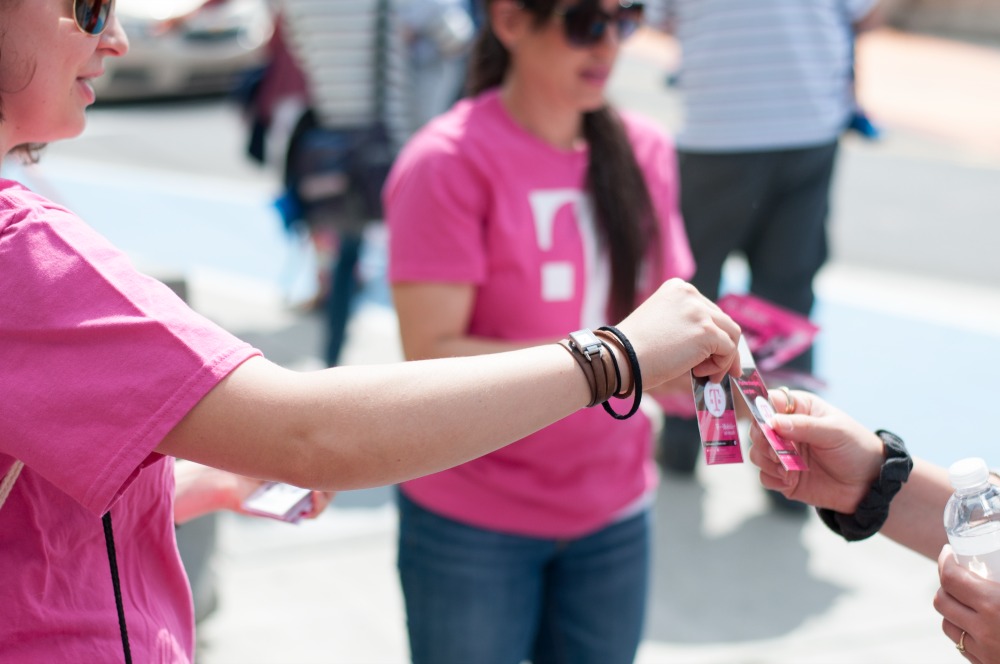Consumers are constantly bombarded with digital marketing messages. It’s hard for brands to cut through the clutter — unless they leverage the power of human engagement.
Street teams interact directly with consumers to build excitement around your brand and connect on a personal level. This excitement translates into action – whether you want to encourage app downloads, product sampling, event attendance, or service trials.
The power of ‘street team’ marketing
We recently worked on a nationwide project for a top ride-sharing brand. The goal was to build brand awareness and increase app downloads with a coupon code offer for your first ride. We hired and trained event managers and brand ambassadors for mobile street team events in 11 markets. We also activated street teams on college campuses around the country.
Brand ambassadors talked to almost 1,500 consumers during the 5-month campaign. As a result, 20 percent of those engagements led to app downloads using the coupon code incentive
When executed correctly, a street team initiative can increase brand awareness, build loyalty and increase sales. But when executed incorrectly, a street team initiative can waste money and damage a brand’s reputation. If you have ever encountered an untrained street team glued to their smartphones, clustered together and blocking the sidewalk, or shouting at you as you walk by, you know what I mean.
Build your brand with street teams
Here are nine tips that can help you successfully use street teams to increase brand awareness and acquire new customers:
1. Set a goal
Setting a goal allows you to measure success. How many consumers do you want to download your app, sample your product, attend your event, sign up for your service, or take some other action? With our nationwide ride-sharing project, the goal was to get as many downloads as possible.
2. Be strategic
Who are you trying to reach and where are they? When you know your target audience you can put street teams in the best locations with the right messaging. Your street team should interact with consumers for a long enough time period to make a difference. Focus on high-traffic areas. Also give your street team incentives to work harder and connect with more people.
3. Set a realistic budget
Street teams are cost-effective when used strategically. I’ve seen companies cut corners by recruiting individuals through social media for a one-time event, telling them when and where to show up, handing them a stack of flyers when they arrived and expecting great results. But it doesn’t work that way.
4. Train brand ambassadors
You want people to feel they are joining a street team that is not only fun but well organized and designed to achieve a specific goal. To kick things off, provide a welcome packet and an introductory orientation and training meeting. This way, new hires feel they are an integral part of the team. Training materials can include talking points, company information, FAQs, etc. We hired outgoing and engaging people who were comfortable approaching strangers.
5. Place an event manager on-site
The event manager gets the team energized and prepared for the day. This role also has the authority to deal with last-minute surprises, like no-shows and weather-related problems. Our event manager for the ride-sharing initiative monitored the street team to ensure they were doing what was expected and reiterated talking points throughout the event. They were also on-site to ensure consumers were actually downloading the app and using the coupon codes provided.
6. Include a call to action
Make sure consumers know what to do during or after the meeting rather than hoping they’ll figure it out on their own. If your goal is app downloads and service orders, brand ambassadors can walk them through the process and answer questions.
7. Collect data
Make sure you have a way to grab consumer information for analytical purposes and to follow up. For example, you may find Gen Xers are more likely to engage with your brand than millennials or certain parts of the country like your brand better than others. This is good information to have.
8. Measure success
This can be done using sign-up forms, trackable coupon codes or links to landing pages, designating specific phone extensions for callers, and so on. We track our brand ambassadors and ensure that they are doing what they need to do. For our ride-sharing initiative, we measured our success via intensive recaps at the end of each day. We were also in contact with our client about the number of redemption codes used regionally to provide a better visual of success nationwide.
9. Fine-tune and repeat
If you want to ensure success, analyze what worked and what didn’t after each event. Make adjustments as needed to create a high-quality consumer experience.
Street teams are a way to bring mobile apps and other online offerings to life. Rather than staring at a screen, consumers get to interact directly with products and services, and their questions can be answered by the person standing right next to them. In today’s digital age, a personal connection with consumers goes a long way towards fulfilling your brand goals.
This article has been edited.
Joey Kercher is the CEO and founder of Air Fresh Marketing, a premier full-service event staffing and execution marketing agency. A version of this article appeared on Forbes.
© YFS Magazine. All Rights Reserved. Copying prohibited. All material is protected by U.S. and international copyright laws. Unauthorized reproduction or distribution of this material is prohibited. Sharing of this material under Attribution-NonCommercial-NoDerivatives 4.0 International terms, listed here, is permitted.













